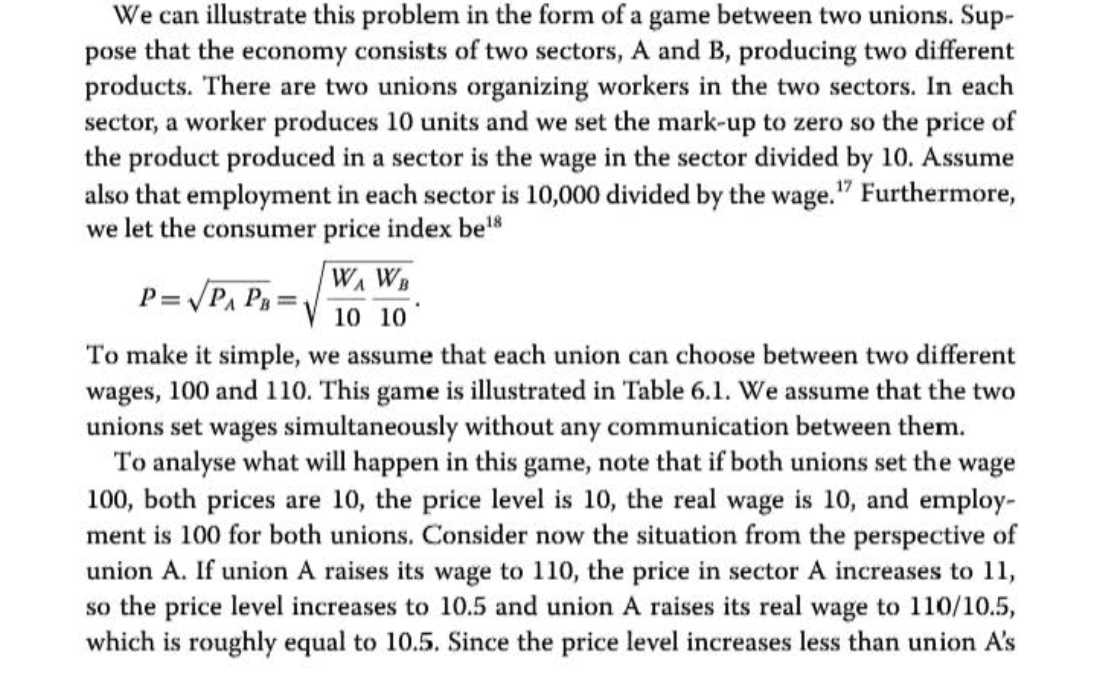Please explain this table as it is very confusing, please explain why the price is w/10? isn't its suppose to be w=p/10 therefore p=10*w?
WH = 100 W= = 110 100 100 W = 100 WA WB P= WAW . 100 110 10 10 = 10 10 10 P =1 10 10 -10.5 10 10 WA 100 WB 100 WA 100 WB 110 P 10 - = 10, p 10 = 10 P 10.5 9.5, P 10.5 10.5 10000 10000 10000 10000 N= = 100, NB= = 100 N= 100 100 = 100, NA= : 91 100 110 WA = 110 WAWE 110 100 P = 1 WA W B 110 110 10 10 10.5 10 10 V 10 10 10 10 =11 WA = 10.5, W BA 9.5 P A = 10, WB = 10 P p p 10000 10000 MA= 10000 10000 110 - 91, N:= = 100 MA = 100 291, NA= 110 110 91 wage, union A gets a real wage increase. This real wage increase comes at the cost of reduced employment, so the union faces a trade-off. If the union does not want to raise the wage, and the same applies to union B, the wage 100 is the equilibrium wage in the sense that neither union wants to deviate from this equilibrium. But union A may consider that lower employment is a reasonable price to pay for a higher real wage. So union A may prefer to set the wage at 110, and union B may think the same way. In such a case, a situation where both unions set the wage, 100 is not an equilibrium situation because both unions have incentives to deviate from this equilibrium and set a higher wage. So what happens if both unions raise their wages to 110? This is seen in the lower right box of Table 6.1. Wages are 10 percent higher but prices are also 10 percent higher, so there is no change in the real wage compared with the case when wages were 100. The only thing that has been achieved by the higher wages is a lower level of employment. Unions would have been better off if wages had been 100 than they are when wages are 110, but if unions act in an uncoordinated way, each union has an incen- tive to raise the wage to 110 and the equilibrium is where both unions set this wage. In effect, each union tries to set a higher wage than the other union but neither union succeeds in doing this.19We can illustrate this problem in the form of a game between two unions. Sup- pose that the economy consists of two sectors, A and B, producing two di'erent products. There are two unions organizing workers in the two sectors. in each sector, a worker produces 10 units and we set the mark-up to zero so the price of the product produced in a sector is the wage in the sector divided by 10. Assume also that employment in each sector is 10,000 divided by the wage." Furthermore. we let the consumer price index be" W, W. P=VP P = . " ' 10 10 To make it simple, we assume that each union can choose between two di'erent wages, 100 and 110. This game is illustrated in Table 6.1. We assume that the two unions set wages simultaneously without any communication between them. To analyse what will happen in this game, note that if both unions set the wage 100, both prices are 10, the price level is 10, the real wage is 10, and employ- ment is 100 for both unions. Consider now the situation from the perspective of union A. if union A raises its wage to 110, the price in sector A increases to 11, so the price level increases to 10.5 and union A raises its real wage to 110/ 10.5, which is roughly equal to 10.5. Since the price level increases less than union A's








